key battery PONTIAC VIBE 2007 Owners Manual
[x] Cancel search | Manufacturer: PONTIAC, Model Year: 2007, Model line: VIBE, Model: PONTIAC VIBE 2007Pages: 432, PDF Size: 2.54 MB
Page 89 of 432
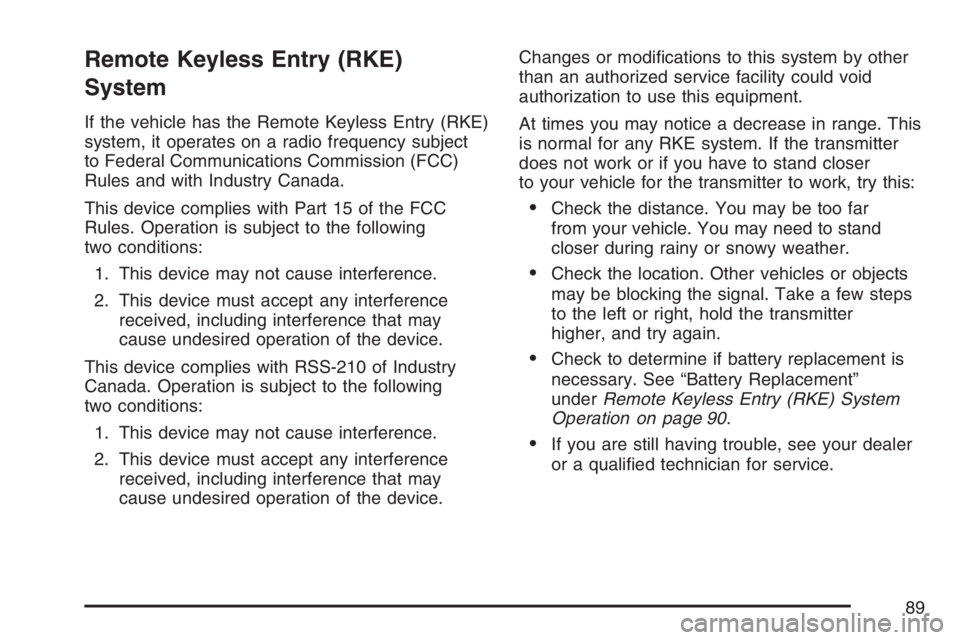
Remote Keyless Entry (RKE)
System
If the vehicle has the Remote Keyless Entry (RKE)
system, it operates on a radio frequency subject
to Federal Communications Commission (FCC)
Rules and with Industry Canada.
This device complies with Part 15 of the FCC
Rules. Operation is subject to the following
two conditions:
1. This device may not cause interference.
2. This device must accept any interference
received, including interference that may
cause undesired operation of the device.
This device complies with RSS-210 of Industry
Canada. Operation is subject to the following
two conditions:
1. This device may not cause interference.
2. This device must accept any interference
received, including interference that may
cause undesired operation of the device.Changes or modi�cations to this system by other
than an authorized service facility could void
authorization to use this equipment.
At times you may notice a decrease in range. This
is normal for any RKE system. If the transmitter
does not work or if you have to stand closer
to your vehicle for the transmitter to work, try this:
Check the distance. You may be too far
from your vehicle. You may need to stand
closer during rainy or snowy weather.
Check the location. Other vehicles or objects
may be blocking the signal. Take a few steps
to the left or right, hold the transmitter
higher, and try again.
Check to determine if battery replacement is
necessary. See “Battery Replacement”
underRemote Keyless Entry (RKE) System
Operation on page 90.
If you are still having trouble, see your dealer
or a quali�ed technician for service.
89
Page 91 of 432
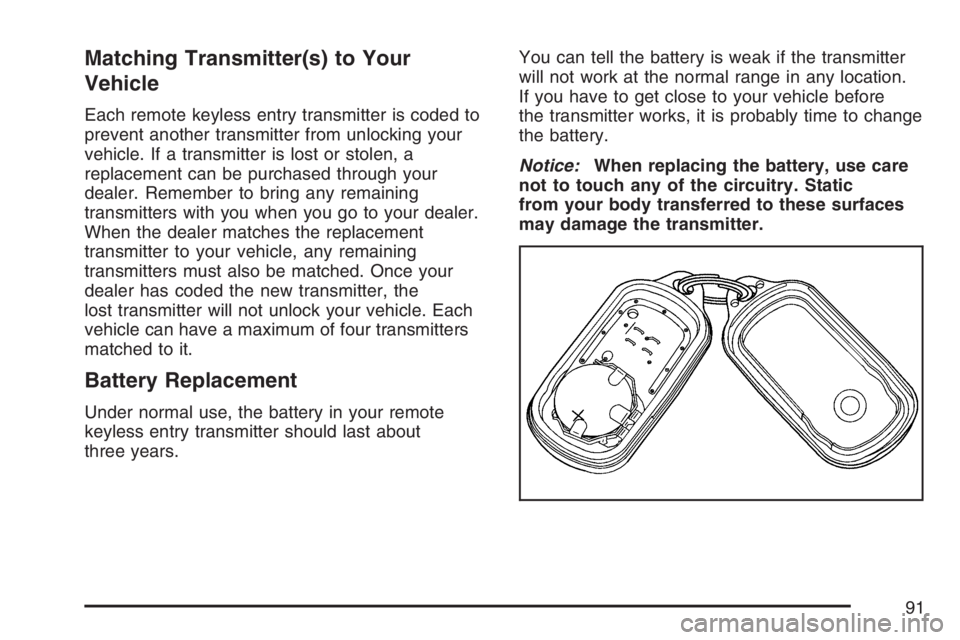
Matching Transmitter(s) to Your
Vehicle
Each remote keyless entry transmitter is coded to
prevent another transmitter from unlocking your
vehicle. If a transmitter is lost or stolen, a
replacement can be purchased through your
dealer. Remember to bring any remaining
transmitters with you when you go to your dealer.
When the dealer matches the replacement
transmitter to your vehicle, any remaining
transmitters must also be matched. Once your
dealer has coded the new transmitter, the
lost transmitter will not unlock your vehicle. Each
vehicle can have a maximum of four transmitters
matched to it.
Battery Replacement
Under normal use, the battery in your remote
keyless entry transmitter should last about
three years.You can tell the battery is weak if the transmitter
will not work at the normal range in any location.
If you have to get close to your vehicle before
the transmitter works, it is probably time to change
the battery.
Notice:When replacing the battery, use care
not to touch any of the circuitry. Static
from your body transferred to these surfaces
may damage the transmitter.
91
Page 100 of 432

Theft-Deterrent Systems
Vehicle theft is big business, especially in some
cities. Although your vehicle has a number of
theft-deterrent features, we know that nothing we
put on it can make it impossible to steal.
Content Theft-Deterrent
If your vehicle has this feature, the theft-deterrent
system is designed to activate an alarm if any
of the side doors or the liftgate is forcibly unlocked
or if the battery terminal is disconnected and
then reconnected while the system is set.
The alarm will sound the horn intermittently and
�ash the headlamps, turn signal lamps and interior
lights. If the driver’s or front passenger’s side
doors are unlocked forcibly, the other side doors
and the liftgate will be locked automatically.
Arming the System
To arm the system, do the following:
1. Turn the ignition key to the LOCK position
and remove it.
2. Close and lock all doors and liftgate with the
key or remote keyless entry transmitter.The indicator light
located on the
instrument panel to the
left of the steering
wheel will come
on when all doors and
liftgate are closed
and locked.
The system will be automatically set after
30 seconds. When the system is set,
the indicator light will start �ashing.
3. After the indicator light starts �ashing, you
may leave the vehicle.
Do not leave anyone in the vehicle when you
set the system, because unlocking the
vehicle from the inside will activate the system.
100
Page 101 of 432
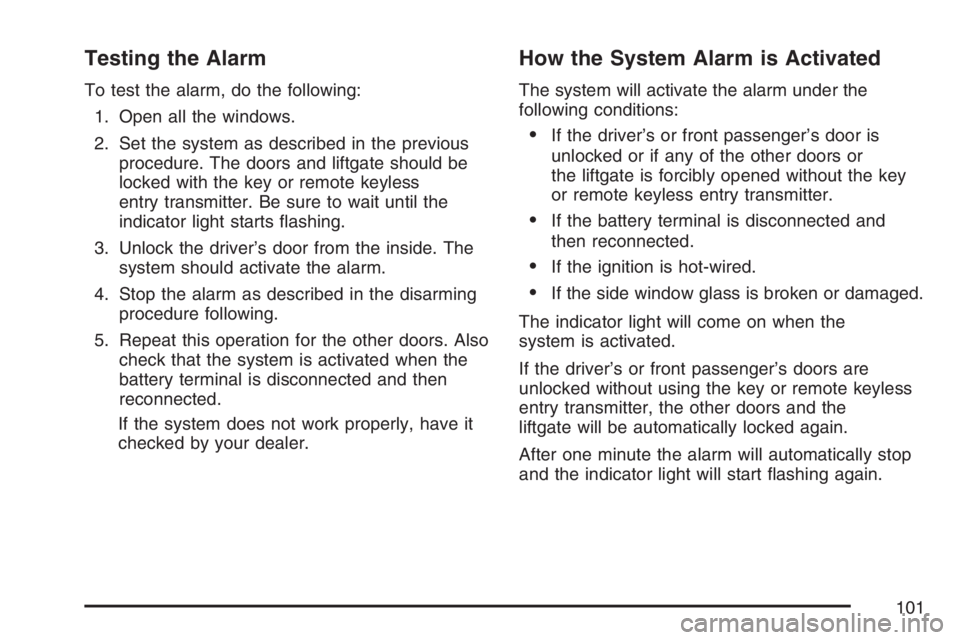
Testing the Alarm
To test the alarm, do the following:
1. Open all the windows.
2. Set the system as described in the previous
procedure. The doors and liftgate should be
locked with the key or remote keyless
entry transmitter. Be sure to wait until the
indicator light starts �ashing.
3. Unlock the driver’s door from the inside. The
system should activate the alarm.
4. Stop the alarm as described in the disarming
procedure following.
5. Repeat this operation for the other doors. Also
check that the system is activated when the
battery terminal is disconnected and then
reconnected.
If the system does not work properly, have it
checked by your dealer.
How the System Alarm is Activated
The system will activate the alarm under the
following conditions:
If the driver’s or front passenger’s door is
unlocked or if any of the other doors or
the liftgate is forcibly opened without the key
or remote keyless entry transmitter.
If the battery terminal is disconnected and
then reconnected.
If the ignition is hot-wired.
If the side window glass is broken or damaged.
The indicator light will come on when the
system is activated.
If the driver’s or front passenger’s doors are
unlocked without using the key or remote keyless
entry transmitter, the other doors and the
liftgate will be automatically locked again.
After one minute the alarm will automatically stop
and the indicator light will start �ashing again.
101
Page 104 of 432
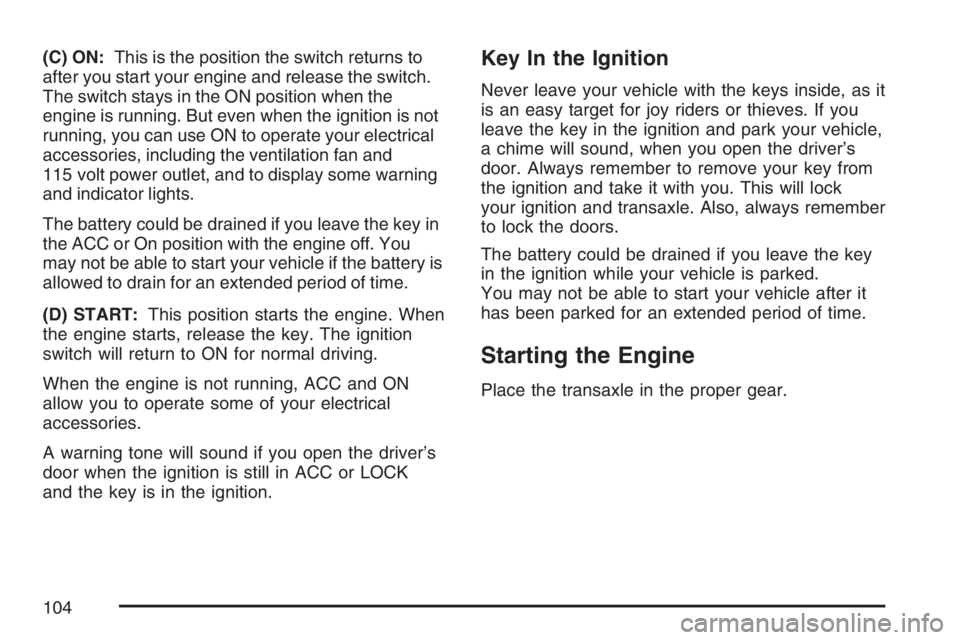
(C) ON:This is the position the switch returns to
after you start your engine and release the switch.
The switch stays in the ON position when the
engine is running. But even when the ignition is not
running, you can use ON to operate your electrical
accessories, including the ventilation fan and
115 volt power outlet, and to display some warning
and indicator lights.
The battery could be drained if you leave the key in
the ACC or On position with the engine off. You
may not be able to start your vehicle if the battery is
allowed to drain for an extended period of time.
(D) START:This position starts the engine. When
the engine starts, release the key. The ignition
switch will return to ON for normal driving.
When the engine is not running, ACC and ON
allow you to operate some of your electrical
accessories.
A warning tone will sound if you open the driver’s
door when the ignition is still in ACC or LOCK
and the key is in the ignition.Key In the Ignition
Never leave your vehicle with the keys inside, as it
is an easy target for joy riders or thieves. If you
leave the key in the ignition and park your vehicle,
a chime will sound, when you open the driver’s
door. Always remember to remove your key from
the ignition and take it with you. This will lock
your ignition and transaxle. Also, always remember
to lock the doors.
The battery could be drained if you leave the key
in the ignition while your vehicle is parked.
You may not be able to start your vehicle after it
has been parked for an extended period of time.
Starting the Engine
Place the transaxle in the proper gear.
104
Page 105 of 432
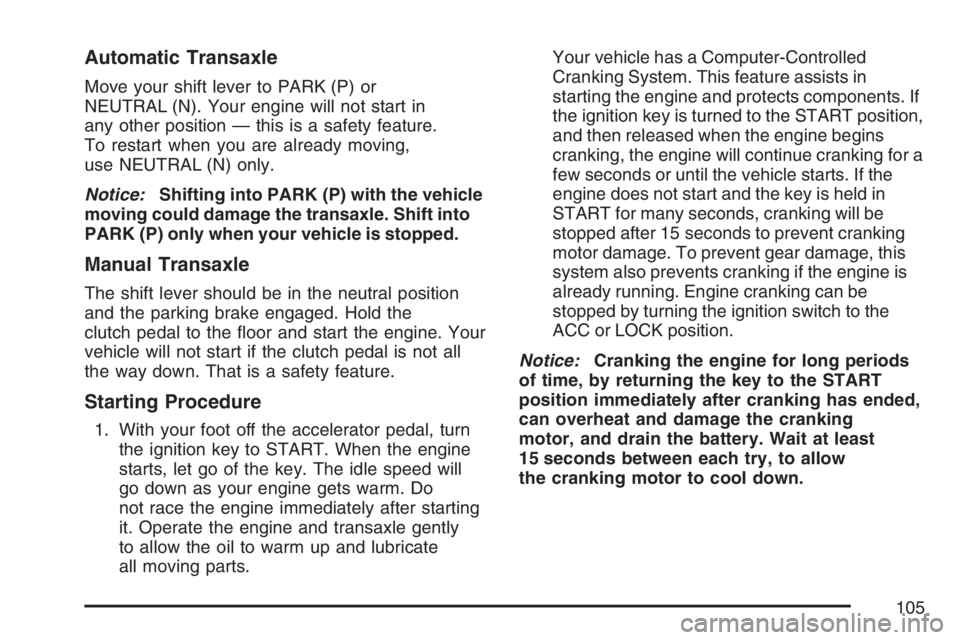
Automatic Transaxle
Move your shift lever to PARK (P) or
NEUTRAL (N). Your engine will not start in
any other position — this is a safety feature.
To restart when you are already moving,
use NEUTRAL (N) only.
Notice:Shifting into PARK (P) with the vehicle
moving could damage the transaxle. Shift into
PARK (P) only when your vehicle is stopped.
Manual Transaxle
The shift lever should be in the neutral position
and the parking brake engaged. Hold the
clutch pedal to the �oor and start the engine. Your
vehicle will not start if the clutch pedal is not all
the way down. That is a safety feature.
Starting Procedure
1. With your foot off the accelerator pedal, turn
the ignition key to START. When the engine
starts, let go of the key. The idle speed will
go down as your engine gets warm. Do
not race the engine immediately after starting
it. Operate the engine and transaxle gently
to allow the oil to warm up and lubricate
all moving parts.Your vehicle has a Computer-Controlled
Cranking System. This feature assists in
starting the engine and protects components. If
the ignition key is turned to the START position,
and then released when the engine begins
cranking, the engine will continue cranking for a
few seconds or until the vehicle starts. If the
engine does not start and the key is held in
START for many seconds, cranking will be
stopped after 15 seconds to prevent cranking
motor damage. To prevent gear damage, this
system also prevents cranking if the engine is
already running. Engine cranking can be
stopped by turning the ignition switch to the
ACC or LOCK position.
Notice:Cranking the engine for long periods
of time, by returning the key to the START
position immediately after cranking has ended,
can overheat and damage the cranking
motor, and drain the battery. Wait at least
15 seconds between each try, to allow
the cranking motor to cool down.
105